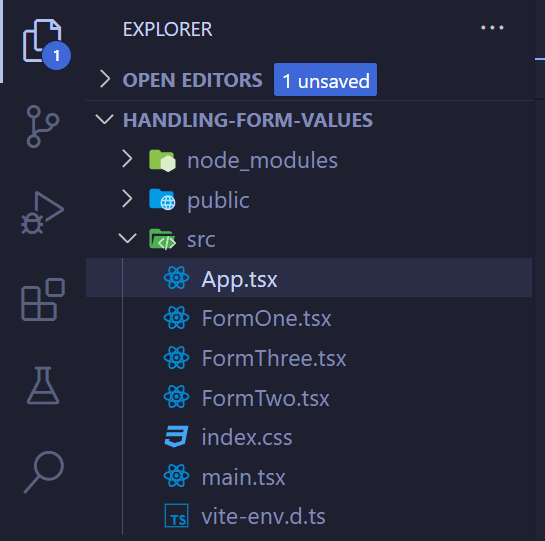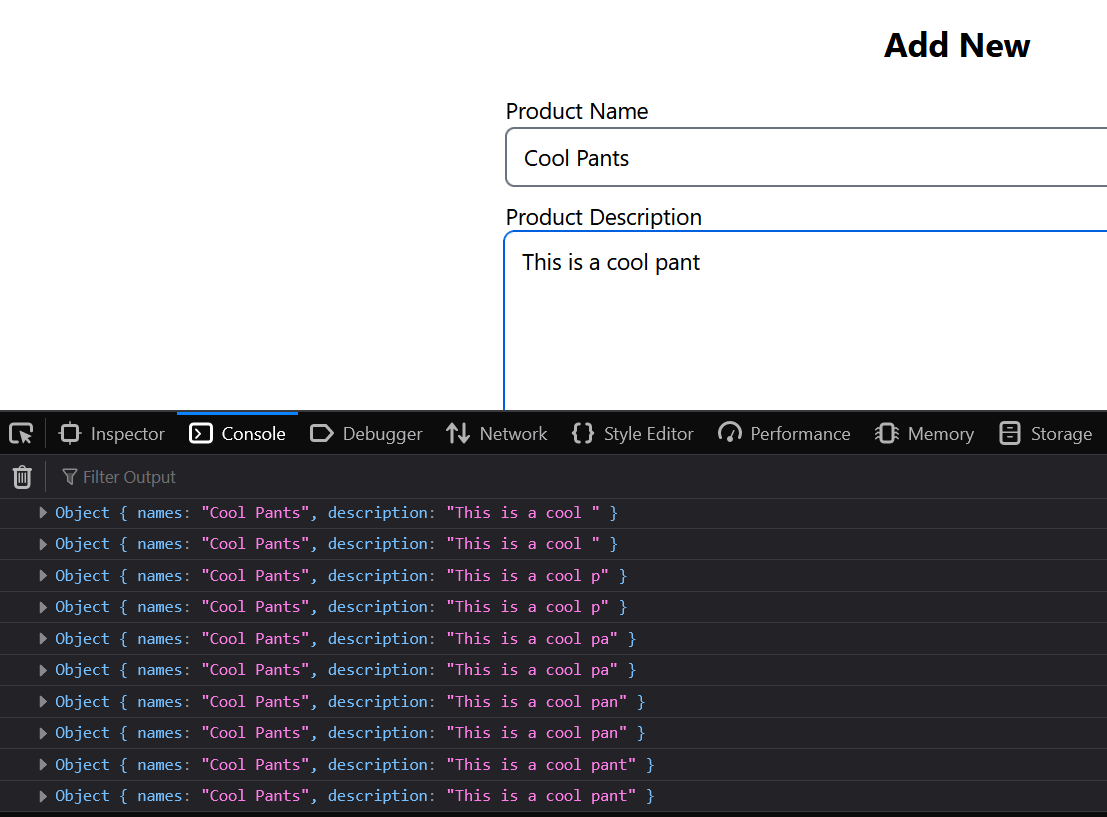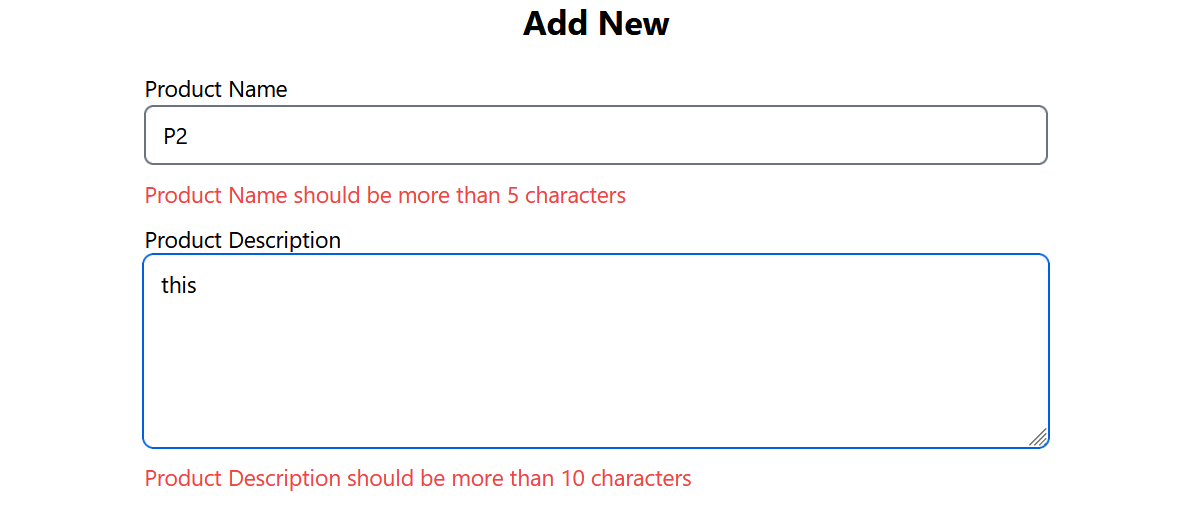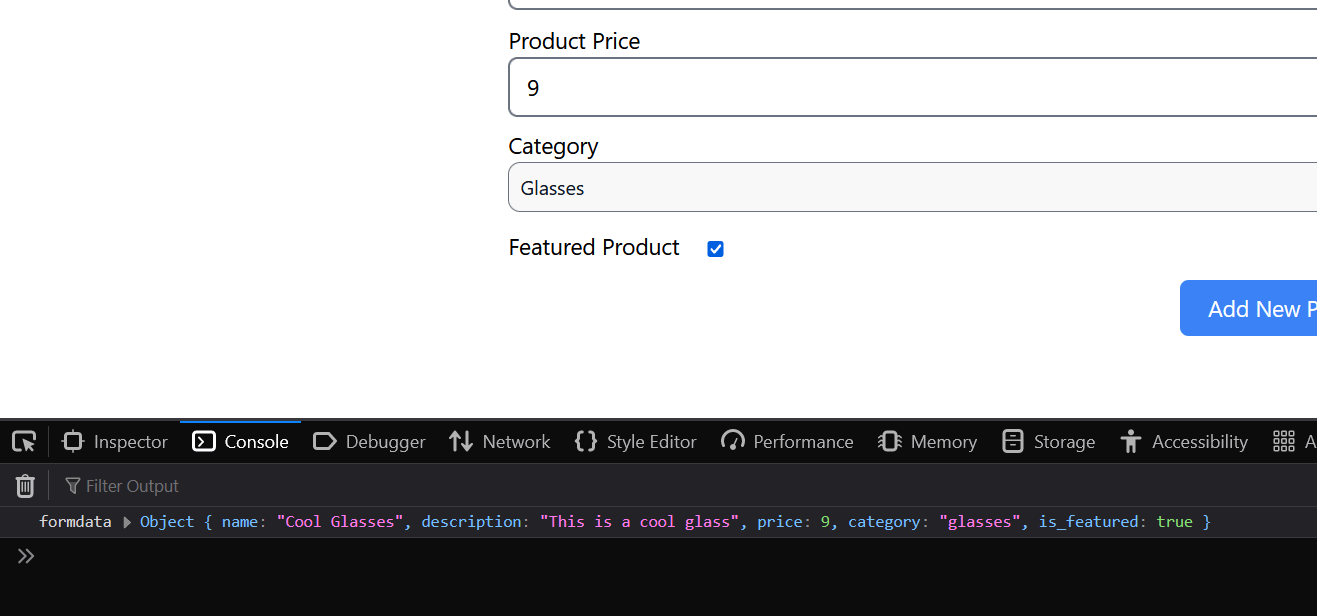How to Get values from Form Input Values (3 ways) in React and Next.js (including form validation)
Published On
Forms are essential part of the webpages. They are used in some way or other. So handling forms are essential as a web developer. In this post I am going to discuss how to get values from the form. Apart from getting values from the input I will also show you how to validate data and show error states.
I will show you 3 methods to get the form methods without any external library or package and in the next post I will discuss about form library React Hook Form and how does it make working with forms very easy.
Setting up Frontend
I have provided you the simple react vite setup with the typescript and tailwind. Download the starter code from the repo github.
The src folder has 6 files. main.tsx, App.tsx For method 1 we will use FormOne for method 2 FormTwo and so on…

This is the repo for this post. Refer it for any code changes.
Here is the video demonstration of what we are going to build
Method 1: useState
This is the most easy to use method to collect the form values. Here is a simplified example.
const [nameInput, setNameInput] = useState("")
<input name="name"
id="name"
className="..."
onChange = {(event)=> setNameInput(event.target.value)}
/>
Now you can easily access the value of the input through the nameInput value of useState.
Now let’s say you have 10 fields so you will have to make 10 seperate useState values and that will be a lot. So have have single useState for all the input where values are stored as an object.
Here is the simplified example.
const [formValues, setFormValues] = useState()
<label htmlFor="name">Name</label>
<input
name="name"
id="name"
className="..."
onChange={(event) =>
setFormValues({ ...formValues, name: event.target.value })
}
/>
<label htmlFor="description">Description</label>
<input name="description"
id="description"
className="..."
onChange = {(event)=> setFormValues({...formValues, description: event.target.value})}
/>
Now again if you will see we are repeating some stuff over. Like {(event)=> setFormValues({...formValues, name: event.target.value})} and {(event)=> setFormValues({...formValues, name: event.target.value})}. Now here if you will see for name we have name and for description we have description. That field name of the object is basically the name field of html input elment, so we can get that by [event.target.name].
So let’s make a generic function handleInputChange
const [formValues, setFormValues] = useState()
const handleInputChange = (
event: React.ChangeEvent<HTMLInputElement | HTMLTextAreaElement>
) => {
setFormData({
...formData,
[event.target.name]: event.target.value,
});
};
<label htmlFor="name">Name</label>
<input
name="name"
id="name"
className="..."
onChange={(event) => handleInputChange(event)}
/>
<label htmlFor="description">Description</label>
<input name="description"
id="description"
className="..."
onChange = {(event)=> handleInputChange(event)}
/>
Now we console.log the values formData. Here’s the output

Now let’s add some validation checks. It will depend on your project requirement. Here I am considering product name is required should be more than 5 characters and less than 50 characters. In similar way description should be more than 10 characters and less than than 150 characters. Based on this validation we will show error states.
const [formValues, setFormValues] = useState()
const handleInputChange = (
event: React.ChangeEvent<HTMLInputElement | HTMLTextAreaElement>
) => {
setFormData({
...formData,
[event.target.name]: event.target.value,
});
};
<label htmlFor="name">Name</label>
<input
name="name"
id="name"
className="..."
required
minLength={5}
maxLength={50}
onChange={(event) => handleInputChange(event)}
/>
{formData?.name && formData.name.length < 5 && (
<p className="text-red-500 mb-2">
Product Name should be more than 5 characters
</p>
)}
{formData?.name && formData.name.length > 50 && (
<p className="text-red-500 mb-2">
Product Name should not be more than 50 characters
</p>
)}
{formData?.name?.length === 0 && (
<p className="text-red-500 mb-2">Product Name is required</p>
)}
<label htmlFor="description">Description</label>
<input
name="description"
id="description"
required
minLength={5}
maxLength={150}
className="..."
onChange={(event) => handleInputChange(event)}
/>
{formData?.description && formData.description.length < 5 && (
<p className="text-red-500 mb-2">
Product Description should be more than 10 characters
</p>
)}
{formData?.description && formData.description.length > 150 && (
<p className="text-red-500 mb-2">
Product Description should not be more than 150 characters
</p>
)}
{formData?.description?.length === 0 && (
<p className="text-red-500 mb-2">Product Description is required</p>
)}

Now this validation logic needs to be repeated again in the submit form section too right. So let’s bring zod which is used to validation.
npm i zod
Let’s declare the form schema for the entire form.
import {z} from "zod"
const formSchema = z.object({
name: z
.string({ required_error: "Name is required" })
.min(5, { message: "Name must be more than 5 characters" })
.max(50, { message: "Name must be less than 50 characters" })
.trim(),
description: z
.string({ required_error: "Description is required" })
.min(10, { message: "Description must be more than 10 characters" })
.max(150, { message: "Description must be less than 150 characters" })
.trim(),
price: z.coerce
.number({ required_error: "Price is required" })
.min(0, { message: "Price should be more than 0" }),
category: z
.string({ required_error: "Category is required" })
.refine((val) => val !== "uncategorised", {
message: "Choose category other than uncategorised",
}),
is_featured: z.boolean(),
});
We will use this schema for our useState also also currently with nothing initial value typescript must be throwing a lot of errors.
const [formData, setFormData] = useState<z.infer<typeof formSchema>>({
name: "",
description: "",
price: 0,
is_featured: false,
});
Also lets remove the manual validation errors that we are added and let’s use zod schema for parsing and generating error.
const [formError, setFormError] = useState<z.ZodFormattedError<FormSchema, string> | null>(null);
useEffect(() => {
const parsedData = formSchema.safeParse(formData);
if (!parsedData.success) {
const err = parsedData.error.format();
setFormError(err);
} else{
setFormError(null)
}
}, [formData]);
...
{formError?.description?._errors?.map((err) => (
<p className="text-red-500 mb-2" key={err}>
{err}
</p>
))}
I have added one more state that will keep track of which state has user visited and contains error. We will error for those inputs only.
Now while submitting the form, the data will be parsed the formValues against the schema. If it is successfully parsed then we will move forward or else we will throw the error and prevent form submitting.
Here is final code
import { FormEvent, useEffect, useState } from "react";
import { z } from "zod";
const formSchema = z.object({
name: z
.string({ required_error: "Name is required" })
.min(5, { message: "Name must be more than 5 characters" })
.max(50, { message: "Name must be less than 50 characters" })
.trim(),
description: z
.string({ required_error: "Description is required" })
.min(10, { message: "Description must be more than 10 characters" })
.max(150, { message: "Description must be less than 150 characters" })
.trim(),
price: z.coerce
.number({ required_error: "Price is required" })
.min(0, { message: "Price should be more than 0" }),
category: z
.string({ required_error: "Category is required" })
.refine((val) => val !== "uncategorised", {
message: "Choose category other than uncategorised",
}),
is_featured: z.boolean(),
});
type FormSchema = z.infer<typeof formSchema>;
const FormOne = () => {
const [formData, setFormData] = useState<z.infer<typeof formSchema>>({
name: "",
description: "",
price: 0,
is_featured: false,
category: "",
});
const [formError, setFormError] = useState<z.ZodFormattedError<
FormSchema,
string
> | null>(null);
const [touchedInput, setTouchedInput] = useState<string[]>([]);
const handleInputChange = (
event: React.ChangeEvent<
HTMLInputElement | HTMLTextAreaElement | HTMLSelectElement
>
) => {
if (!touchedInput.includes(event.target.name)) {
setTouchedInput([...touchedInput, event.target.name]);
}
if (event.target.type === "checkbox") {
if (event.target && event.target instanceof HTMLInputElement) {
setFormData({
...formData,
[event.target.name]: event.target.checked,
});
}
} else {
setFormData((prev) => ({
...prev,
[event.target.name]: event.target.value,
}));
}
};
useEffect(() => {
const parsedData = formSchema.safeParse(formData);
if (!parsedData.success) {
const err = parsedData.error.format();
setFormError(err);
} else {
setFormError(null);
}
}, [formData]);
const handleSubmit = async (e: FormEvent) => {
e.preventDefault();
try {
const parsedFormValue = formSchema.safeParse(formData);
if (!parsedFormValue.success) {
const err = parsedFormValue.error.format();
setFormError(err);
return;
}
// send data to database
console.log("formdata", parsedFormValue.data);
} catch (error) {
console.log("caught error");
//handle additional erros ...
}
};
return (
<>
<div className="my-10 w-full">
<h2 className="text-2xl text-center font-bold">Add New</h2>
<form onSubmit={handleSubmit} className="lg:w-1/2 mx-auto px-5 py-5">
<label className=" block" htmlFor="name">
Product Name
</label>
<input
type="text"
min={2}
max={50}
className="border-2 mb-2 border-gray-500 focus-visible:border-0 focus-visible:outline-2 rounded-md px-3 py-2 w-full"
onChange={(event) => handleInputChange(event)}
name="name"
id="text"
required
/>
{touchedInput.includes("name") && formError?.name && (
<>
{formError?.name?._errors.map((err) => (
<p className="text-red-500 mb-2" key={err}>
{err}
</p>
))}
</>
)}
<label className="block" htmlFor="description">
Product Description
</label>
<textarea
minLength={10}
maxLength={150}
rows={5}
className="border-2 mb-2 border-gray-500 focus-visible:border-0 focus-visible:outline-2 rounded-md px-3 py-2 w-full"
name="description"
id="description"
onChange={(event) => handleInputChange(event)}
required
/>
{touchedInput.includes("description") && formError?.description && (
<>
{formError?.description?._errors?.map((err) => (
<p className="text-red-500 mb-2" key={err}>
{err}
</p>
))}
</>
)}
<label className="block" htmlFor="price">
Product Price
</label>
<input
className="border-2 mb-2 border-gray-500 focus-visible:border-0 focus-visible:outline-2 rounded-md px-3 py-2 w-full"
type="number"
name="price"
min={0}
id="price"
onChange={(event) => handleInputChange(event)}
required
/>
{touchedInput.includes("price") && formError?.name && (
<>
{formError?.price?._errors?.map((err) => (
<p className="text-red-500 mb-2" key={err}>
{err}
</p>
))}
</>
)}
<label htmlFor="category">Category</label>
<select
name="category"
id="category"
className=" border bg-[#f8f8f8] border-gray-500 text-gray-900 text-sm rounded-lg focus:ring-blue-500 focus:border-blue-500 block w-full p-2 "
onChange={(event) => handleInputChange(event)}
>
<option value="uncategorised">Choose a category</option>
<option value="shirts">Shirts</option>
<option value="pants">Pants </option>
<option value="glasses">Glasses</option>
<option value="hats">Hats</option>
</select>
{touchedInput.includes("category") && formError?.name && (
<>
{formError?.category?._errors?.map((err) => (
<p className="text-red-500 mb-2" key={err}>
{err}
</p>
))}
</>
)}
<label className="my-3 inline-block" htmlFor="is_featured">
Featured Product
</label>
<input
id="is_featured"
name="is_featured"
className="ml-5"
type="checkbox"
onChange={(event) => handleInputChange(event)}
/>
<div className="flex justify-end">
<button className=" bg-blue-500 hover:scale-95 transition-all duration-75 ease-in px-5 py-2 rounded-md text-white">
Add New Product
</button>
</div>
</form>
</div>
</>
);
};
export default FormOne;
I am not very fond of this method as it triggers re-render on every change. Please remember rerender here in this case is not much that big of an issue. React handles rerender pretty well. But still we have optimised methods so let’s see them.
Method 2: useRef
If you want to prevent this re-render problem then you can use the useRef function. Read about useRef fom react docs.
in App.tsx comment FormOne and uncomment FormTwo.
Simplified example for useRef.
const nameInput = useRef<HTMLInputElement>(null);
const handleSubmit = async (e: FormEvent) => {
e.preventDefault();
console.log(nameInput.current?.value);
};
<input
type="text"
min={2}
max={50}
className="border-2 mb-2 border-gray-500 focus-visible:borderfocus-visible:outline-2 rounded-md px-3 py-2 w-full"
name="name"
id="text"
ref={nameInput}
required
/>
Now we will make use of the zod schema to validate the input.
Here is the complete code.
import { z } from "zod";
import { useRef, FormEvent, useState } from "react";
const formSchema = z.object({
name: z
.string({ required_error: "Name is required" })
.min(5, { message: "Name must be more than 5 characters" })
.max(50, { message: "Name must be less than 50 characters" })
.trim(),
description: z
.string({ required_error: "Description is required" })
.min(10, { message: "Description must be more than 10 characters" })
.max(150, { message: "Description must be less than 150 characters" })
.trim(),
price: z.coerce
.number({ required_error: "Price is required" })
.min(0, { message: "Price should be more than 0" }),
category: z
.string({ required_error: "Category is required" })
.refine((val) => val !== "uncategorised", {
message: "Choose category other than uncategorised",
}),
is_featured: z.boolean(),
});
type FormSchema = z.infer<typeof formSchema>;
const FormTwo = () => {
const nameInput = useRef<HTMLInputElement>(null);
const descriptionInput = useRef<HTMLTextAreaElement>(null);
const priceInput = useRef<HTMLInputElement>(null);
const categoryInput = useRef<HTMLSelectElement>(null);
const featuredInput = useRef<HTMLInputElement>(null);
const [formError, setFormError] = useState<z.ZodFormattedError<
FormSchema,
string
> | null>(null);
const handleSubmit = async (e: FormEvent) => {
e.preventDefault();
const formData = {
name: nameInput.current?.value,
description: descriptionInput.current?.value,
price: priceInput.current?.value,
category: categoryInput.current?.value,
is_featured: featuredInput.current?.checked,
};
try {
const parsedFormValue = formSchema.safeParse(formData);
if (!parsedFormValue.success) {
const err = parsedFormValue.error.format();
setFormError(err);
return;
} else {
setFormError(null);
}
console.log("formdata", parsedFormValue.data);
} catch (error) {
console.log(error);
}
};
return (
<>
<div className="my-10 w-full">
<h2 className="text-2xl text-center font-bold">Add New</h2>
<form onSubmit={handleSubmit} className="lg:w-1/2 mx-auto px-5 py-5">
<label className=" block" htmlFor="name">
Product Name
</label>
<input
type="text"
min={2}
max={50}
className="border-2 mb-2 border-gray-500 focus-visible:border-0 focus-visible:outline-2 rounded-md px-3 py-2 w-full"
name="name"
id="text"
ref={nameInput}
required
/>
{formError?.name && (
<>
{formError?.name?._errors.map((err) => (
<p className="text-red-500 mb-2" key={err}>
{err}
</p>
))}
</>
)}
<label className="block" htmlFor="description">
Product Description
</label>
<textarea
maxLength={150}
minLength={10}
rows={5}
className="border-2 mb-2 border-gray-500 focus-visible:border-0 focus-visible:outline-2 rounded-md px-3 py-2 w-full"
name="description"
id="description"
ref={descriptionInput}
required
/>
{formError?.description && (
<>
{formError?.description?._errors.map((err) => (
<p className="text-red-500 mb-2" key={err}>
{err}
</p>
))}
</>
)}
<label className="block" htmlFor="price">
Product Price
</label>
<input
className="border-2 mb-2 border-gray-500 focus-visible:border-0 focus-visible:outline-2 rounded-md px-3 py-2 w-full"
type="number"
name="price"
min={0}
id="price"
ref={priceInput}
required
/>
{formError?.price && (
<>
{formError?.price?._errors.map((err) => (
<p className="text-red-500 mb-2" key={err}>
{err}
</p>
))}
</>
)}
<label htmlFor="category">Category</label>
<select
name="category"
id="category"
ref={categoryInput}
className=" border bg-[#f8f8f8] border-gray-500 text-gray-900 text-sm rounded-lg focus:ring-blue-500 focus:border-blue-500 block w-full p-2 "
>
<option value="uncategorised">Choose a category</option>
<option value="shirts">Shirts</option>
<option value="pants">Pants </option>
<option value="glasses">Glasses</option>
<option value="hats">Hats</option>
</select>
{formError?.category && (
<>
{formError?.category?._errors.map((err) => (
<p className="text-red-500 mb-2" key={err}>
{err}
</p>
))}
</>
)}
<label className="my-3 inline-block" htmlFor="is_featured">
Featured Product
</label>
<input
id="is_featured"
name="is_featured"
className="ml-5"
type="checkbox"
ref={featuredInput}
defaultChecked={false}
/>
<div className="flex justify-end">
<button className=" bg-blue-500 hover:scale-95 transition-all duration-75 ease-in px-5 py-2 rounded-md text-white">
Add New Product
</button>
</div>
</form>
</div>
</>
);
};
export default FormTwo;
Heads Up:
You must be thinking that that we have added basic validation like length and required in the element itself so that will be handled by browser, so what’s the use of formError useState and
{
formError?.name && (
<>
{formError?.name?._errors.map((err) => (
<p className="text-red-500 mb-2" key={err}>
{err}
</p>
))}
</>
);
}
The reason I have added this is because browser validation is not that hard to bypass. You can use inspect elements and edit it right? So you need to validate data server side also. Now suppose their is error so return that error and set that error in formError state.
Method 3: using FormData Constructor
I am using this method quite a lot these day as it is very easy. In this method we are going to use the FormData constructor. This is nothing react specific it can be used in vanilla js or any other framework. It just takes form element as one of the parameters. Read more about this on mdn docs.
Simplified example
const handleSubmit = async (e: FormEvent) => {
e.preventDefault();
const formData = new FormData(e.target as HTMLFormElement);
console.log(formData.get("name"));
}
...
<form onSubmit={hanldeSubmit}>
...
</form>
Please comment FormTwo and uncomment FormThree in App.tsx
Complete code for FormThree
import { FormEvent, useState } from "react";
import { z } from "zod";
const formSchema = z.object({
name: z
.string({ required_error: "Name is required" })
.min(5, { message: "Name must be more than 5 characters" })
.max(50, { message: "Name must be less than 50 characters" })
.trim(),
description: z
.string({ required_error: "Description is required" })
.min(10, { message: "Description must be more than 10 characters" })
.max(150, { message: "Description must be less than 150 characters" })
.trim(),
price: z.coerce
.number({ required_error: "Price is required" })
.min(0, { message: "Price should be more than 0" }),
category: z
.string({ required_error: "Category is required" })
.refine((val) => val !== "uncategorised", {
message: "Choose category other than uncategorised",
}),
is_featured: z.boolean(),
});
type FormSchema = z.infer<typeof formSchema>;
const FormThree = () => {
const [formError, setFormError] = useState<z.ZodFormattedError<
FormSchema,
string
> | null>(null);
const handleSubmit = async (e: FormEvent) => {
e.preventDefault();
const formData = new FormData(e.target as HTMLFormElement);
const formDataValues = {
name: formData.get("name"),
description: formData.get("description"),
price: formData.get("price"),
category: formData.get("category"),
is_featured: Boolean(formData.get("is_featured")),
};
try {
const parsedFormValue = formSchema.safeParse(formDataValues);
if (!parsedFormValue.success) {
const err = parsedFormValue.error.format();
console.log(err);
setFormError(err);
return;
} else {
setFormError(null);
}
console.log("formdata", parsedFormValue.data);
} catch (error) {
console.log(error);
}
};
return (
<>
<div className="my-10 w-full">
<h2 className="text-2xl text-center font-bold">Add New</h2>
<form onSubmit={handleSubmit} className="lg:w-1/2 mx-auto px-5 py-5">
<label className=" block" htmlFor="name">
Product Name
</label>
<input
type="text"
min={2}
max={50}
className="border-2 mb-2 border-gray-500 focus-visible:border-0 focus-visible:outline-2 rounded-md px-3 py-2 w-full"
name="name"
id="text"
required
/>
{formError?.name && (
<>
{formError?.name?._errors.map((err) => (
<p className="text-red-500 mb-2" key={err}>
{err}
</p>
))}
</>
)}
<label className="block" htmlFor="description">
Product Description
</label>
<textarea
maxLength={150}
minLength={10}
rows={5}
className="border-2 mb-2 border-gray-500 focus-visible:border-0 focus-visible:outline-2 rounded-md px-3 py-2 w-full"
name="description"
id="description"
required
/>
{formError?.description && (
<>
{formError?.description?._errors.map((err) => (
<p className="text-red-500 mb-2" key={err}>
{err}
</p>
))}
</>
)}
<label className="block" htmlFor="price">
Product Price
</label>
<input
className="border-2 mb-2 border-gray-500 focus-visible:border-0 focus-visible:outline-2 rounded-md px-3 py-2 w-full"
type="number"
name="price"
min={0}
id="price"
required
/>
{formError?.price && (
<>
{formError?.price?._errors.map((err) => (
<p className="text-red-500 mb-2" key={err}>
{err}
</p>
))}
</>
)}
<label htmlFor="category">Category</label>
<select
name="category"
id="category"
className=" border bg-[#f8f8f8] border-gray-500 text-gray-900 text-sm rounded-lg focus:ring-blue-500 focus:border-blue-500 block w-full p-2 "
>
<option value="uncategorised">Choose a category</option>
<option value="shirts">Shirts</option>
<option value="pants">Pants </option>
<option value="glasses">Glasses</option>
<option value="hats">Hats</option>
</select>
{formError?.category && (
<>
{formError?.category?._errors.map((err) => (
<p className="text-red-500 mb-2" key={err}>
{err}
</p>
))}
</>
)}
<label className="my-3 inline-block" htmlFor="is_featured">
Featured Product
</label>
<input
id="is_featured"
name="is_featured"
className="ml-5"
type="checkbox"
defaultChecked={false}
/>
<div className="flex justify-end">
<button className=" bg-blue-500 hover:scale-95 transition-all duration-75 ease-in px-5 py-2 rounded-md text-white">
Add New Product
</button>
</div>
</form>
</div>
</>
);
};
export default FormThree;
Here is the output

Conclusion
So in this post we learnt how to handle forms in react and how to get values from input. In this post we also implemented the validation using zod library. This is the final repo for this article.
In the upcoming posts I am going to discuss server actions in nextjs and also using React Hook Form library for handling forms much easier and with much lesser code.
If you have any doubt, you can contact me via form or via the EverythingCS discord server